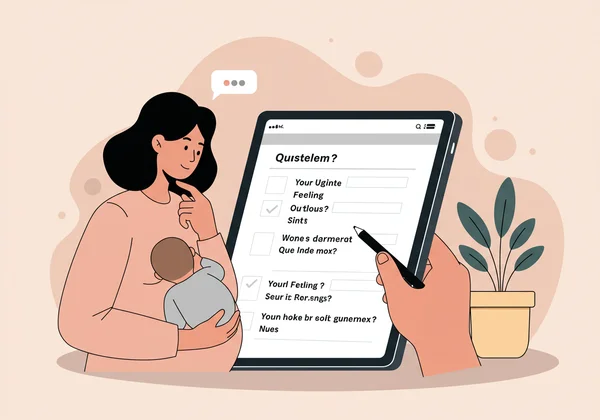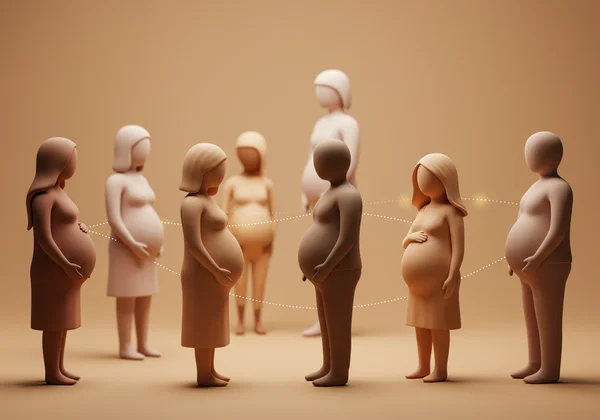什麼是愛丁堡產後憂鬱量表 (EPDS)?完整指南
懷孕和產後時期在情緒上可能充滿挑戰。雖然喜悅和興奮很常見,但悲傷、焦慮和不知所措的感覺也非常普遍。如果您有這些感覺,請知道您並不孤單,而且有工具可以提供幫助。愛丁堡產後憂鬱量表 (EPDS) 是最廣泛使用且最受信賴的工具之一,用於識別圍產期情緒 及 焦慮 相關 症狀。
本指南將帶您了解有關 EPDS 測試的所有必需資訊,包括它是什麼、如何運作、分數的意義,以及 — 最重要的是 — 如何獲得您應得的幫助。
醫療免責聲明: EPDS 是一個有價值的 篩檢工具,但它 不是診斷。結果應與合格的醫療保健專業人員(例如您的醫生、助產士或心理健康治療師)分享和討論,他們可以提供準確的診斷並制定治療計劃。
什麼是愛丁堡產後憂鬱量表 (EPDS)?
愛丁堡產後憂鬱量表是一份包含 10 個問題的自我報告問卷,旨在篩檢懷孕和產後期間的憂鬱和焦慮症狀。它由研究人員 Cox、Holden 和 Sagovsky 於 1987 年開發,已成為識別可能需要進一步心理健康評估和支持的父母的全球標準。
EPDS 的主要目的是開啟關於心理健康的對話,並提供一種簡單有效的方法來及早發現潛在的圍產期憂鬱。

誰應該進行 EPDS 測試?
EPDS 專為圍產期的人設計。這包括:
- 孕婦: 懷孕期間的篩檢可以識別產前憂鬱或焦慮,從而實現早期干預。
- 產後人士: 該測試最常用於分娩後的數週和數月。建議在產後約 6-8 週進行一次,並在其他關鍵時間點再次進行。
- 伴侶和領養父母: 雖然最初是為親生母親設計的,但 EPDS 也可以成為伴侶和領養父母的有用工具,他們也可能經歷產後憂鬱或焦慮。
如果您持續感到悲傷、焦慮、易怒或失去樂趣,進行 EPDS 問卷調查可以是一個有價值的初步步驟。

理解您的 EPDS 分數
EPDS 問卷包含 10 個關於您過去七天情緒的問題。每個回應的得分範圍從 0 到 3。總分是將這 10 個問題的得分相加計算得出的,結果在 0 到 30 之間。
EPDS 分數範圍與解釋
雖然解釋應始終由醫療保健提供者進行,但分數通常表示如下:
- 分數 0-9: 這被認為是低風險範圍。您可能正在經歷「產後情緒低落」(baby blues),但不太可能患有嚴重的憂鬱症。但是,如果您仍然擔心您的感受,您應該諮詢您的醫生。
- 分數 10-12: 這個分數表明可能有輕度憂鬱。 此分數強烈建議您與醫療保健專業人員討論您的結果與感受,以進行更全面的評估。
- 分數 13 或更高: 這個分數表明憂鬱的可能性很高。您必須盡快尋求醫生或心理健康專家的專業評估。
第 10 題的關鍵重要性
EPDS 的第 10 題詢問有關自我傷害的想法。 該特定問題的任何得分大於 0 都是一個警訊,無論總 EPDS 分數如何。如果您有任何傷害自己的想法, 立即尋求協助至關重要。 立即聯繫您的醫生、前往最近的急診室或致電危機熱線。
EPDS 上有哪些問題?
EPDS 的問題旨在評估您情緒和情感狀態的各個方面。它們不詢問您的身體症狀,而是側重於感受。涵蓋的主題範例包括:
- 能夠笑並從事物中找到樂趣的能力
- 期待令人愉快的事物
- 不必要地責怪自己
- 無緣無故感到焦慮或擔心
- 恐慌或害怕的感覺
- 感到不知所措
- 睡眠困難或悲傷
- 自我傷害的想法
主要限制:EPDS 是一個篩檢工具,不是診斷
重要的是要記住這個產後憂鬱測試的目的和限制:
- 它是快照: 測試僅反映您過去七天的感受。
- 它是篩檢工具: 高分並不意味著您患有臨床憂鬱症。這意味著您有症狀, 需要專業評估。
- 需要背景資訊: 醫療保健提供者將您的 EPDS 分數與您的個人病史、當前情況以及臨床訪談結合起來,以做出準確的診斷。
後續步驟:測試後該怎麼做
完成愛丁堡產後憂鬱量表是優先考慮您心理健康的一項積極步驟。

- 進行測試: 如果您準備好了,您可以在 Epds.me 網站上進行 EPDS 測試。
- 討論您的分數: 安排與您的家庭醫生、婦產科醫生、助產士或心理健康專業人士預約,討論您的分數以及您的感受。請坦誠相待。
- 尋求支持: 聯繫您信任的朋友、家人或支持團體。像 Postpartum Support International (PSI) 這樣的組織提供寶貴的資源、求助熱線以及與訓練有素的專業人士的聯繫。
您的情緒健康與身體健康 同樣重要。使用 EPDS 作為指導,可以賦予您力量,讓您開始對話並獲得茁壯成長所需的支援。
常見問題
EPDS 測試是免費的嗎?
是的,EPDS 問卷本身是公共領域的工具。我們的網站 Epds.me 提供免費的線上版本,方便您存取。
完成測試需要多長時間?
EPDS 非常簡短,通常不到 5 分鐘即可完成。
我可以為別人進行 EPDS 測試嗎?
不可以。EPDS 是一份自我報告問卷。為了準確起見,答案必須反映受測者個人的感受。如果您關心您的親人,請鼓勵他們進行測試並 諮詢 醫療保健提供者。